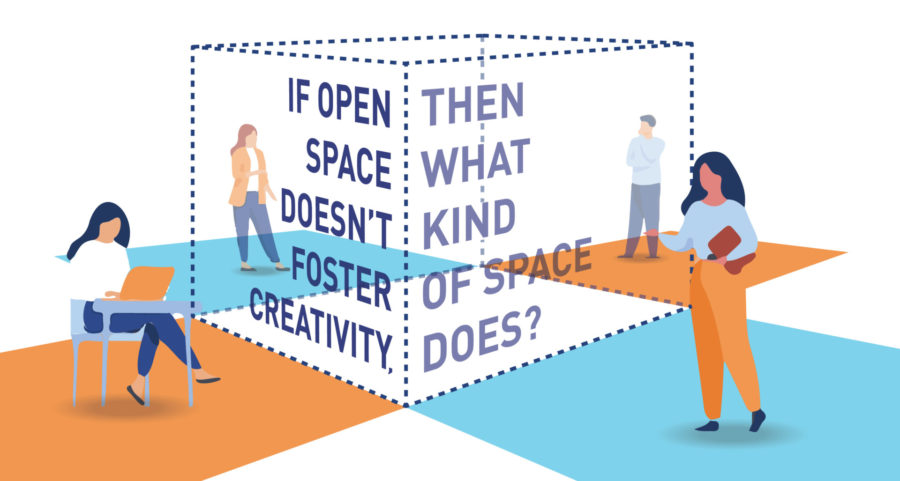Insights
Nov 2, 2022 _ insights
Fostering Collaboration & Inspiration for a Workplace Culture that Doesn’t Exist (Yet)
In two previous articles (here and here), we described the emergence of what the Brookings Institute calls, “a new geography of innovation.” Once sequestered in suburban research parks, in the last decade the most innovative companies and entrepreneurs are finding their way into more dense urban areas.
They’re re-locating in innovation districts, where they work in close proximity to other innovative companies, institutions, and researchers. In many cases, they’re not only finding new neighbors, but they’re forming new partnerships in shared workplaces. But drawing people together from across campus and from across multiple industries isn’t easy. It’s a new problem that requires a new solution.
Innovation + Workplace Cultures that Don’t Yet Exist
How can architecture cultivate connections between researchers with different projects and backgrounds? How can it draw people together from across the university or from different institutions who have no experience working together? In short, how can architects create spaces that contribute to the emergence of new ideas?
One possible answer is “nothing.” Kyle Hagerty suggests this in his provocative article, “You Can’t Hack Innovation or Productivity with Office Design.” “Cleverly designed office space is nice,” he writes, “but we have to stop acting like building a prettier maze will help the mouse find the cheese faster.” Hagerty’s point is that worker/manager relationships are extremely important. That’s true, and design can’t substitute for mutual trust and support. Nevertheless, design can do a lot to foster or hinder healthy work relationships, especially when the space is bringing new people together for the first time.
We know the layout and design of a workplace can nurture or hinder the growth of relationships. In fact, Hagerty himself cites a statistic from Harvard Business School study showing that “contemporary open offices led to 70% fewer face-to-face conversations,” because when people lack privacy, they tend to create it by popping in earphones or avoiding eye contact. This shows that open space does not mean automatic connection, but it doesn’t illustrate that workplace design is unimportant. Rather, it means that we have to pay attention to the nuances of how, where, and when those connections are forged.

Workplace design is especially important for the kinds of interdisciplinary innovation hubs that are popping up on and off college campuses across the country. Whether you look at MIT’s Stata Center or Iowa State University’s Student Innovation Center, something these spaces have in common is that they are intended to form new partnerships – partnerships between public and private institutions, between students and professionals, and between researchers in different disciplines.
Many of these spaces also involve rotating research teams, which will make their home there for one to five years before relocating. In this situation, architects find themselves designing for a team and workplace culture that doesn’t yet exist. This makes the design especially important in setting the tone for an incoming cohort of not-yet-coworkers. It needs to create the spaces necessary to support their work, inspire curiosity and imagination, enable relaxation and wellbeing, and foster collaboration.
If undifferentiated, open space doesn’t foster creative collisions, then what kind of spatial strategy does?
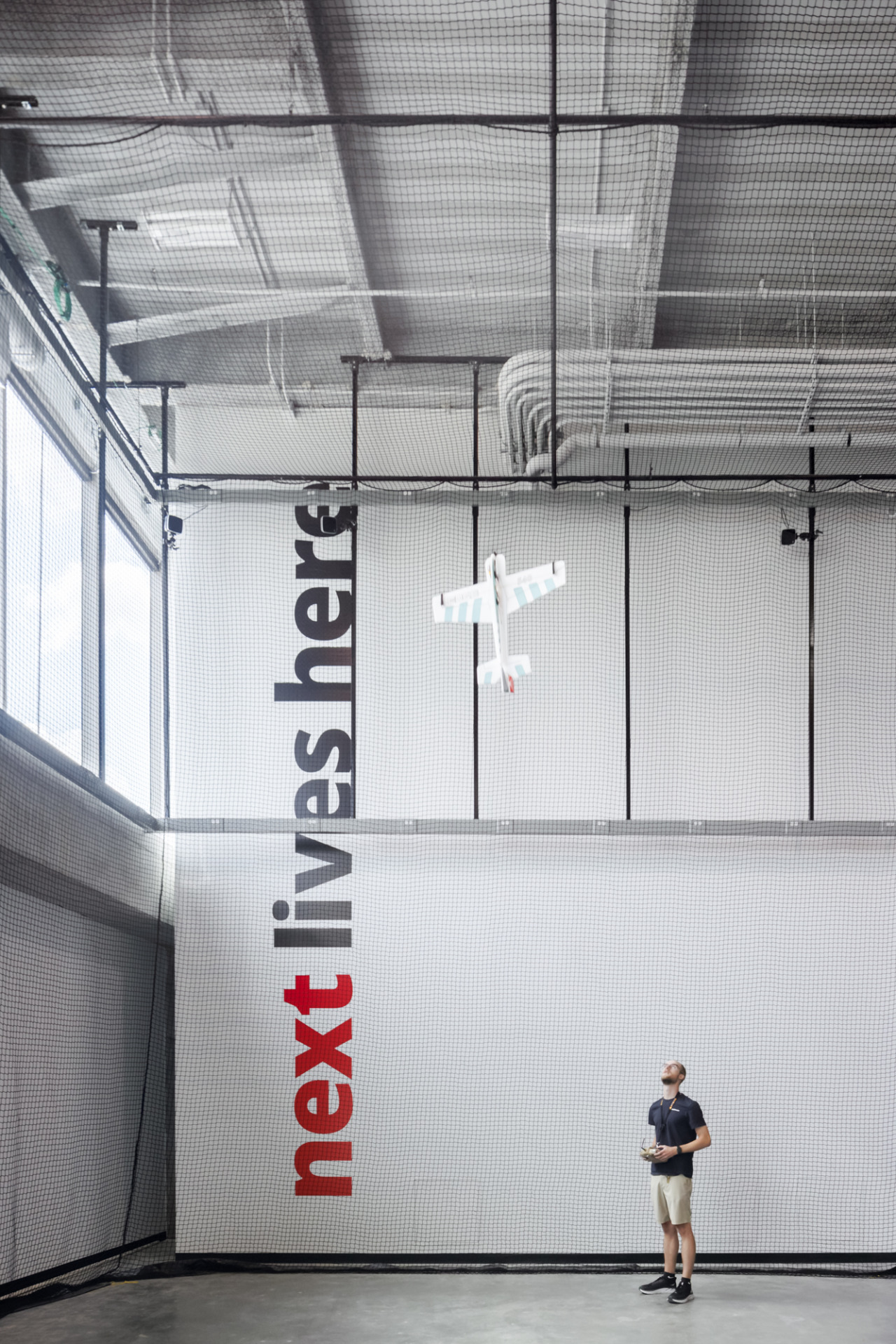
Digital Futures Points the Way
Our design for University of Cincinnati’s Digital Futures develops a strategy to meet this challenge. Bringing some of UC’s most future-forward research teams together with industry partners and colleagues from across the university, Digital Futures develops a multipronged strategy for fostering collaboration and nurturing breakthroughs.
Varied Work Postures + Opportunities to Connect
Organized around “neighborhoods” of lab space and social hubs, Digital Futures gives researchers a choice of how to work—focused and quiet, social, sitting, or standing. Allowing for varied work postures, this enables researchers to choose the place appropriate to their current task and mood. If researchers need privacy, they have it (especially in their labs which are arrayed around the exterior of the building). If they need a change (or a break), they have options for that too. They can work in a coffee shop on the first floor, in the pocket park just outside, or in the more private lounges on the upper floors, where they’re likely to run into someone working on intersecting problems.
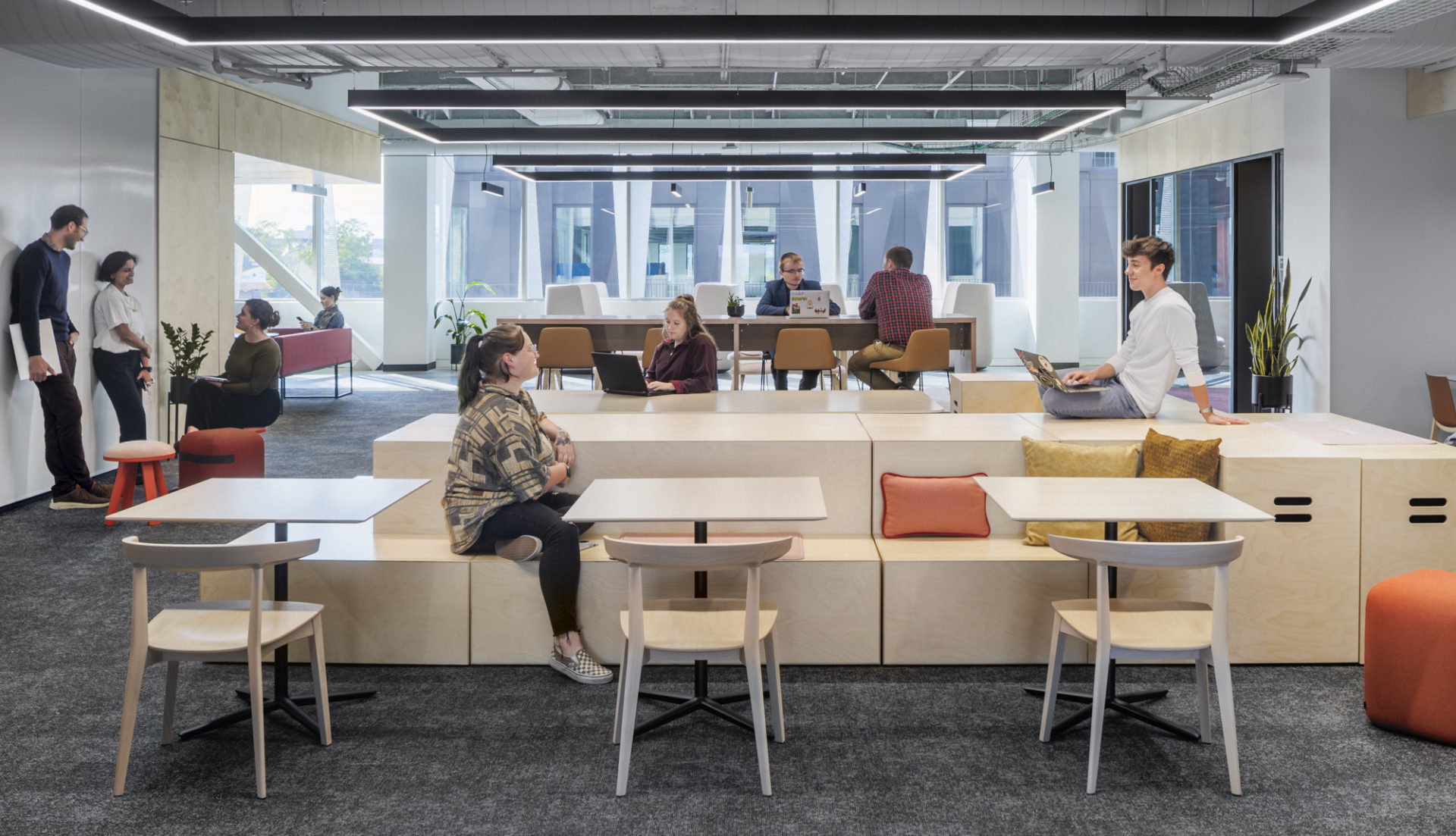
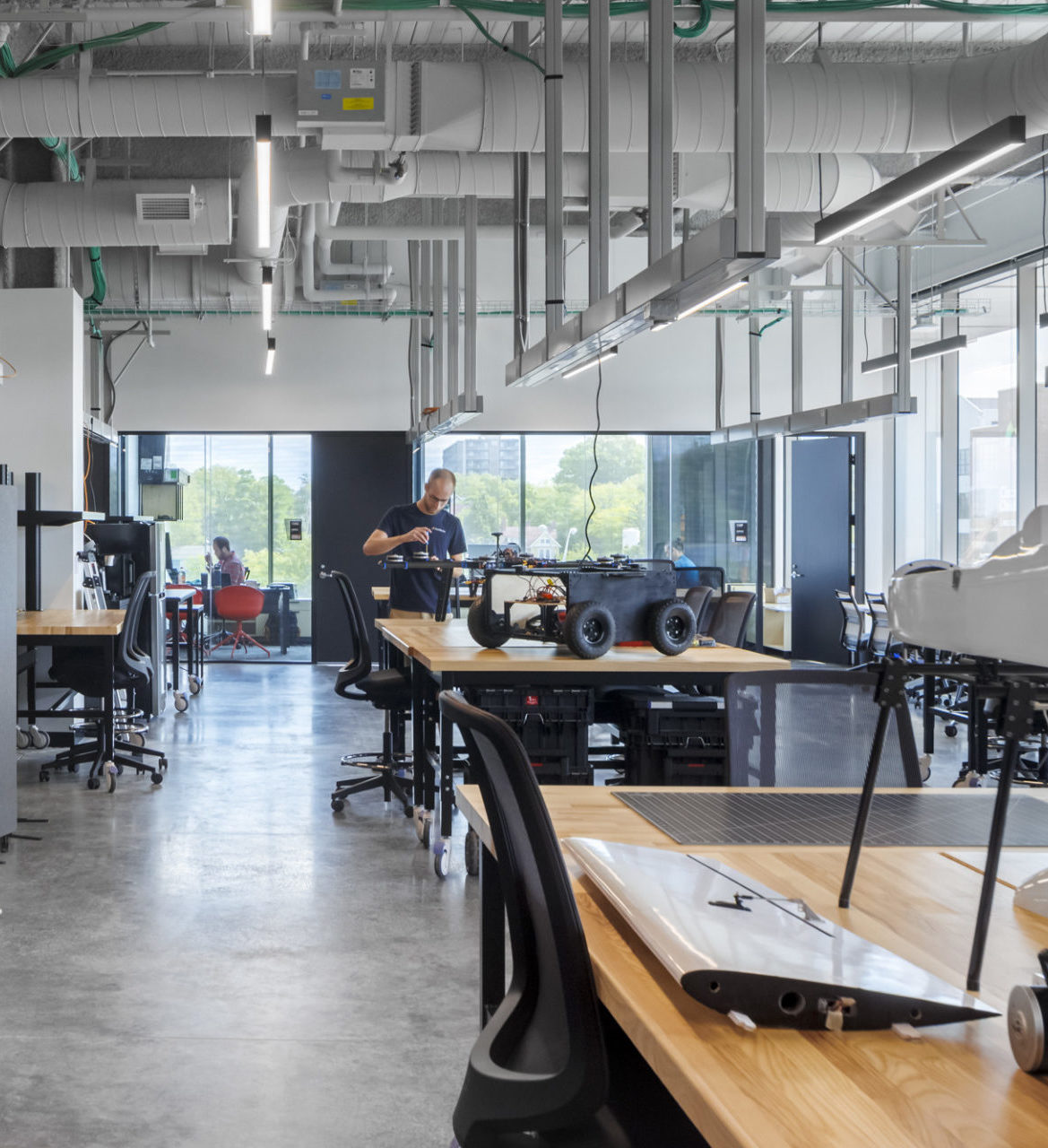 Putting Research on Display
Putting Research on Display
By putting ongoing research on display within social hubs and in a gallery on the main floor, the building creates opportunities to connect disparate lines of investigation. It invites conversation between members of different research teams. Without denying researchers the opportunity and space needed for heads down work, shared resources—VR studios, computer labs, and other specialized amenities—draw investigators together and invite dialogue. Unlike the open office, where people erect ad hoc walls to create privacy, this highly differentiated yet flexible space creates richer opportunities to connect.
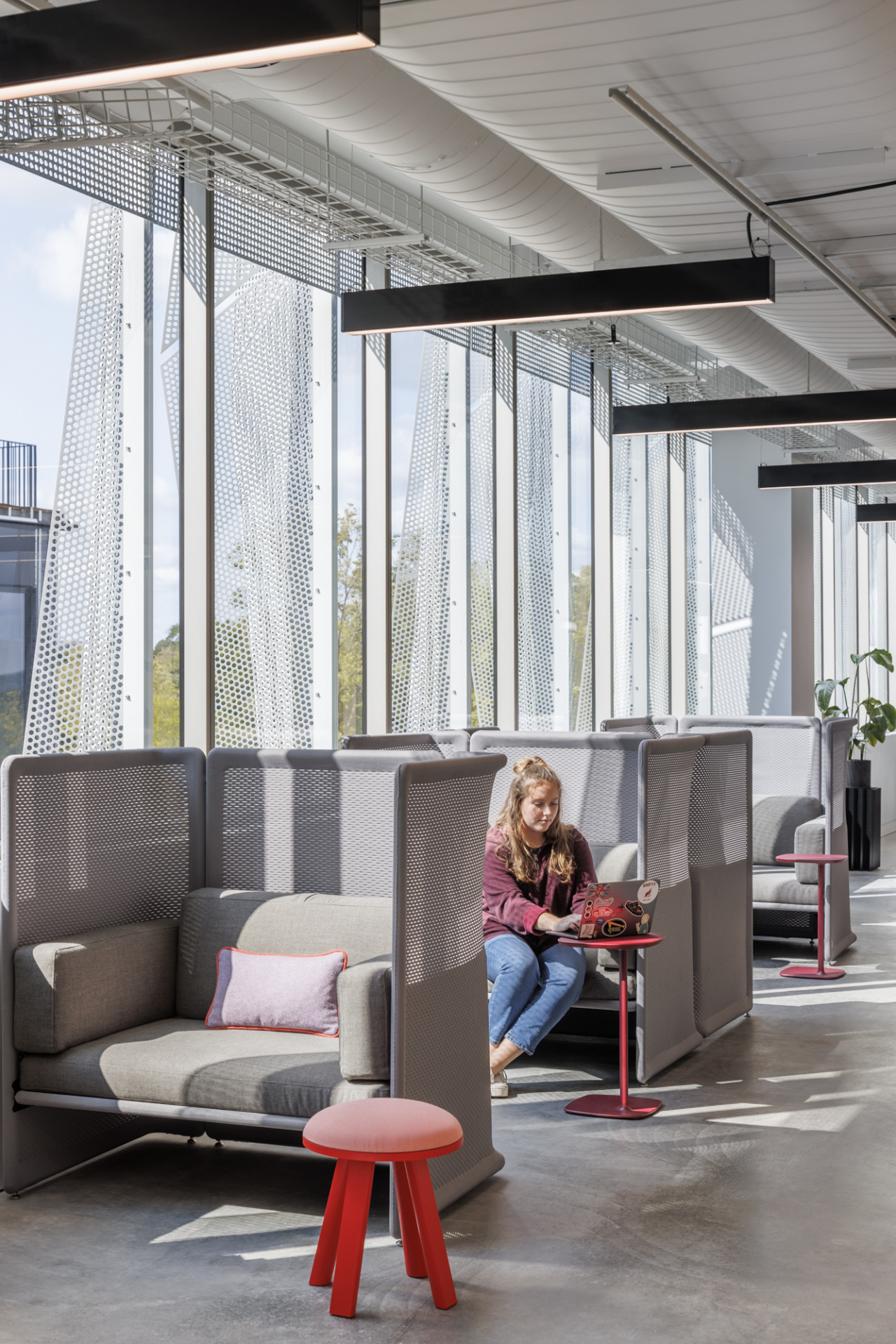 Making Room for Relaxation (and Breakthroughs)
Making Room for Relaxation (and Breakthroughs)
It is also worth underscoring some of the opportunities for relaxation that are integrated into the design. Whether it involves a cup of coffee in the main floor café, a stroll through the gallery, or a nap on one of the couches in the upper floor lounges, the building also enables researchers to take a step back from their work. Cognitive science has shown what we’ve long intuited: Downtime is essential to intellectual breakthroughs. Archimedes’ “Eureka!” moment came in the bath. Newton’s came in a garden. Those at Digital Futures might happen in the little pocket park just outside or while a researcher lets her eyes scan over the abstract patterns on the wood panels that wrap the building’s core. Inspiration is unpredictable, but its patterns are familiar.
Looking Beyond Design
While we don’t share Kyle Hagerty’s dim view of what design can accomplish, it is important to stress that a shift in workplace collaboration is only effective if it is supported by leadership. Design can help shift expectations, but it won’t resolve underlying problems with workplace culture on its own unless supported by leadership. Taking the time to explain the workplace’s design and model the behavior it is intended to support goes a long way to contributing to the success of the space.
Understanding that Digital Futures was very different from the spaces that its researchers were coming from, UC’s leadership team has been proactive in showing the building’s inhabitants how to use the space, through tours, sharing a “users manual” for the building’s amenities, and by example.
A building might not be able to “hack” innovation, but it can create the right conditions to foster connection and innovation.
 Chad Burke, AIA, LEED AP is the Director of Commercial & Workplace at GBBN. Overseeing the firm’s Commercial Mixed-Use and Workplace projects, Chad works closely with developers and workplace clients to design solutions that meet their short-term and long-term needs. His work includes University of Cincinnati’s Digital Futures, Hillrom’s Innovation Center, Uptown Gateway, and Thompson Hine’s Office Renovation. Learn more about his approach to workplace projects here.
Chad Burke, AIA, LEED AP is the Director of Commercial & Workplace at GBBN. Overseeing the firm’s Commercial Mixed-Use and Workplace projects, Chad works closely with developers and workplace clients to design solutions that meet their short-term and long-term needs. His work includes University of Cincinnati’s Digital Futures, Hillrom’s Innovation Center, Uptown Gateway, and Thompson Hine’s Office Renovation. Learn more about his approach to workplace projects here.
 Zachary Zettler, AIA, LEED AP is GBBN’s Director of Higher Education. With over 20 years’ experience designing campus spaces, Zachary is a trusted advisor to our university clients and a recognized leader in higher education design. Zachary’s work includes Miami University’s Stanton Hall Renovation, University of Cincinnati’s Marian Spencer Hall, and University of Cincinnati’s Digital Futures. He has also published insights on repurposing campus spaces and predictive analytics in university masterplans.
Zachary Zettler, AIA, LEED AP is GBBN’s Director of Higher Education. With over 20 years’ experience designing campus spaces, Zachary is a trusted advisor to our university clients and a recognized leader in higher education design. Zachary’s work includes Miami University’s Stanton Hall Renovation, University of Cincinnati’s Marian Spencer Hall, and University of Cincinnati’s Digital Futures. He has also published insights on repurposing campus spaces and predictive analytics in university masterplans.
